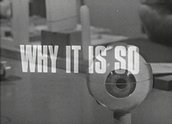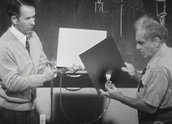

Why It Is So (1973)
Synopsis
Professor Julius Sumner Miller introduces the first in a series of episodes all about ‘light, optics and a brief adventure into modern physics’. After a discourse on our senses, the professor discusses light. He outlines and then conducts an experiment in quantum physics, using a light source and some cardboard, to demonstrate that 'light travels in straight lines’. The professor concludes with an illuminating story about a seven-year-old Sumner Miller’s understanding of light.
Curator’s notes
Why It Is So, which was recorded live from the Physics Department of the University of Sydney, featured the iconic Professor Julius Sumner Miller, a professor of Physics from El Camino College, California. For over two decades, from 1963 to 1986, Sumner Miller and his silent laboratory assistant ‘Mr Anderson’ entertained a surprisingly large ABC television audience in a series of lectures and demonstrations dedicated to questions of physical science. His infectious enthusiasm, animated delivery, wild expressive eyebrows and eccentric turn of phrase meant that science could be fun and entertaining as well as educational.
In the preface to his book, Millergrams (1966), a collection of questions and answers originally published in The Australian newspaper, Sumner Miller expresses his core aspiration for his audience:
To stir your imagination, awaken your interest, arouse your curiosity, enliven your spirit – all with the purpose of bringing you to ask, as young Maxwell put it, 'What’s the go of it?’ – or, as Kepler had it, 'Why things are as they are and not otherwise’. Or, more simply in my own phrase, 'Why is it so?’
Writing on his own early childhood and its influence on his philosophy Sumner Miller explains:
All of a half-century ago – when I was a little boy on the farm in my native New England – I remember asking all kinds of questions. What is the Earth made of? Why is the sky blue? Why is the sunset red? How does a bird soar? Why does a brook gurgle? How does an earthworm crawl? Why is a dewdrop round? Why does corn pop? Why does a wood fire crackle? And a thousand like questions. To a few I got the answers in reading. To some I got the answers in dialogue with my Mama and my Papa and with my teachers. Some I thought out – not too well, to be sure – but I was learning to think.
Each ten-minute episode comprised a lesson in some aspect of ‘quantum physics today’. Content was based on questions drawn from the natural world. Through practical experiments and with his own unique style of commentary, Sumner Miller tried to show how nature behaves and, by asking rather than answering questions, aimed to provoke scientific thought and imagination in his audience.
Sumner Miller was well known for his catchphrase 'Why is it so?’ and the distinctive way he said it entered the vernacular, but his program is titled Why It Is So (see clip one).
- Overview
- Curator’s notes
- Video 2 clips
- Principal credits
- Find a copy
- Make a comment
- Add your review



